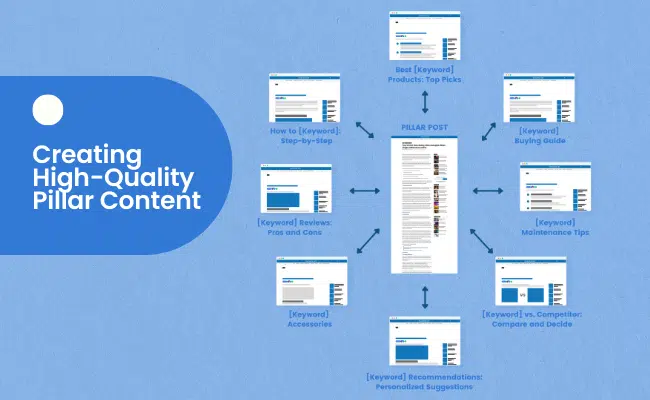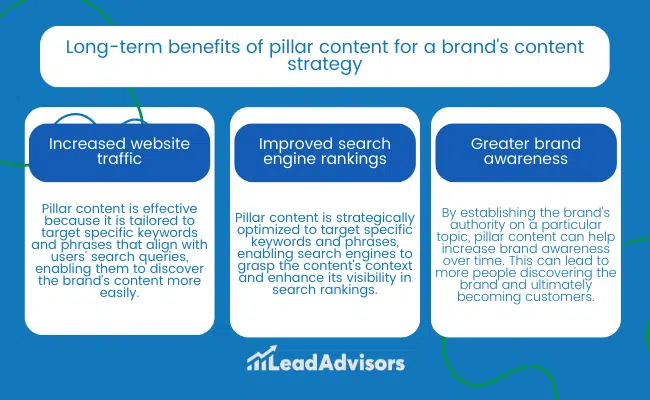If you’ve been exploring SEO strategies, you’ve probably heard the term pillar content vs cluster content more than once – and for good reason. These two approaches work hand-in-hand to organize your content, improve rankings, and make it easier for readers to find what they need. Instead of drowning you in technical jargon, we’ll break it down in a way that’s easy to follow and actually useful.
In the next sections, you’ll learn exactly what pillar and cluster content are, how they connect, and why this structure can make a big difference for your site. We’ll use clear examples and practical tips so you can not only understand the concept but also start implementing it right away.
Understanding Pillar Content

What is Pillar Content?
Pillar content, also known as a pillar page, covers a broad topic in-depth and serves as a resource pillar at the foundation of a content marketing strategy. This resource pillar page uses internal and external links to provide visitors with a complete list of links related to a particular topic.
The primary objective of a pillar page is to deliver valuable information to readers by addressing their most significant inquiries regarding a specific topic. Concurrently, it establishes the brand’s expertise and credibility in that particular subject area.
Pillar content is an integral part of topic clusters, groups of relevant content that revolve around a particular topic. These can identify topic clusters and perform a content gap analysis. Cluster pages or content comprise cluster pages, which provide more specific information related to the topic covered in the pillar page.
Creating comprehensive pillar pages and topic clusters is an effective strategy for building a strong brand identity and increasing site search.
Creating High-Quality Pillar Content

Creating valuable cluster content is an essential aspect of content marketing. A cluster content strategy involves creating a group of related articles centered around a particular topic or theme, each targeting specific and relevant keywords and phrases. This approach can help boost your website’s search engine optimization (SEO) and drive more traffic.
Here are some tips for crafting effective cluster content:
Choose a primary keyword or topic
The first step in creating cluster content is to conduct keyword research on the topic you want to target. When selecting a topic for your content, it is crucial to prioritize choosing a comprehensive and inclusive subject that you aim to rank high on search engine results pages (SERPs).
To illustrate, if your website revolves around fitness, a suitable primary keyword could be “exercise regimens.”
Identify related keywords and entities:
Once you have your primary keyword, you should identify related keywords and entities to create content. These words and phrases are semantically associated with your primary keyword and help provide context and relevance to your content.
For example, some related keywords for “workout routines” might include “strength training,” “cardio exercises,” and “healthy eating.”
Create multiple articles around your primary keyword:
With your primary and related competitive keywords in mind, you should create multiple articles related to your primary topic by following a proven content production process. Each article should target a specific keyword or phrase and provide in-depth, valuable information to your readers.
For example, you might create articles like “10 best strength training exercises,” “5 cardio workouts to burn fat,” and “The benefits of a healthy diet for fitness.”
Use semantically related keywords and entities throughout your content:
As you create your cluster content, use your related keywords and entities throughout your articles. This aids Google search in establishing the significance and context of your content for search engines, boosting your blog post’s search engine ranking and visibility in search results.
Interlink your cluster content with your pillar content:
To further boost the SEO value of your cluster content, you should interlink your article’s service page with your pillar content. Your pillar content is your primary article or page that provides a comprehensive overview of your topic.
Linking your cluster content to your pillar content creates a web of interrelated articles that help search engines understand the depth and breadth of your expertise on the topic, provide value to your readers, and improve your search rankings and online visibility.
Exploring Cluster Content

What is Cluster Content?
Cluster content is a strategic approach to content creation that revolves around creating a series of interlinked blog posts or landing pages centered around a specific topic. Unlike pillar content, which focuses on comprehensive and authoritative coverage of a broad subject, cluster content dives deeper into particular subtopics related to the central pillar page.
Websites can provide more specific and detailed queries and information on subtopics related to the main pillar page. This approach enhances the user experience by offering a wealth of information on a particular subject and keeping visitors on the site longer through strategic content segmentation.
Cluster content can take various forms, including;
- blog posts,
- articles,
- videos,
- infographics,
- or even podcast episodes.
The crucial aspect is that these content pieces strongly emphasize specific subtopics directly connected to the pillar page.
For example, if the first pillar page topic is about “healthy eating habits,” the cluster content could cover subtopics such as “benefits of a plant-based diet,” “meal prep ideas for busy professionals,” or “superfoods for optimal health.”
Each cluster content piece provides in-depth information on a specific aspect while linking to the main pillar page.
Crafting Valuable Cluster Content
Creating high-quality cluster content is essential for a successful content strategy. Cluster content supports the central pillar of the web page and provides more in-depth information on a subtopic.

Here are some tips for crafting valuable cluster content:
- Use semantically related keywords and entities to ensure your content is relevant to the main pillar page and the topic cluster.
- Ensure that the content you deliver to your audience is valuable and informative.
- Interlink your cluster content with your pillar page.
Focusing on semantically related keywords and entities, providing valuable information, and interlinking your cluster content with your pillar page content can help you create an effective and engaging content strategy for your audience.
Brand Recommendation: Pillar Content for Long-Term Success
Content marketing has become vital to any brand’s marketing strategy in today’s digital age. Brands are creating and sharing valuable content with their target audience to establish their authority in their industry, increase brand awareness, and ultimately drive more sales.
However, with the sheer volume of content created, standing out is becoming increasingly challenging. That’s where pillar content comes in.
Pillar content is the foundation of a brand’s content strategy. It’s comprehensive, evergreen content that covers a broad topic in-depth, providing value to the reader. Rather than focusing on short-term gains, brands that invest in creating high-quality pillar content can reap long-term benefits.

Here are some reasons why the brand recommends focusing on blog content, post content, and pillar content:
- Establishes the brand’s authority: Establishing oneself as a thought leader in the industry can be achieved by creating comprehensive and authoritative content centered around a specific topic and leveraging guest blogging opportunities. This helps build trust with its target audience and can ultimately lead to more sales.
- Improves SEO: Pillar content is strategically optimized to target specific keywords and phrases, allowing search engines to grasp the content’s topic and boost its visibility in search rankings.
- Provides a foundation for future content: Pillar content is strategically designed to target specific keywords and phrases, enabling search engines to understand the content’s subject matter and enhance its visibility in search rankings. This creates a web of interrelated content that provides value to the reader and helps establish the brand’s authority on a particular topic.

The long-term benefits of pillar content for a brand’s content strategy are numerous. Here are a few examples:
- Increased website traffic: Brands that create high-quality pillar content can significantly increase website traffic over time. Pillar content is effective because it is tailored to target specific keywords and phrases that align with users’ search queries, enabling them to discover the brand’s content more easily.
- Improved search engine rankings: Pillar content is strategically optimized to target specific keywords and phrases, enabling search engines to grasp the content’s context and enhance its visibility in search rankings. Over time, this can improve the brand’s content’s search engine rankings.
- Greater brand awareness: Pillar content can help increase brand awareness over time by establishing the brand’s authority on a particular topic. This can lead to more people discovering the brand and ultimately becoming customers.
Successful pillar content implementation can be seen across many industries. For example, HubSpot’s “The Ultimate Guide to Marketing” is an excellent example of pillar content. It covers a broad topic in-depth and provides value to the reader, establishing HubSpot as a thought leader in the marketing industry.
Another example is Neil Patel’s “Advanced Guide to SEO.” This comprehensive guide covers everything a reader needs to know about SEO, establishing Neil Patel as an authority.

According to a recent study conducted by HubSpot, companies that consistently published a minimum of 16 blog posts per month witnessed a significant increase in website traffic. In fact, these businesses received nearly 3.5 times more traffic than those that published only 0-4 blog posts monthly.
Furthermore, the study also found that companies that went above and beyond by publishing over 401 blog posts experienced a remarkable boost in traffic. Specifically, they obtained 2.5 times more traffic than companies that published 0-100 blog posts.
These statistics highlight the long-term benefits of investing in high-quality pillar content for a brand’s content strategy.
Frequently Asked Questions
What is pillar content?
How is cluster content different from pillar content?
Why should I link cluster content to pillar content?
How do I choose topics for pillar and cluster content?
What are the long-term benefits of using a pillar–cluster content strategy?
Conclusion
Understanding the difference between pillar content and cluster content is crucial in unlocking content strategy success for your website or blog. Pillar content serves as the foundation of your site, while cluster content supports it by diving deeper into subtopics related to the pillar.
By creating a well-structured and interconnected web of content, you can improve your website’s SEO, increase engagement with your audience, and establish yourself as an authority in your industry.
If you’re looking to improve your content strategy, Lead Advisors has an excellent blog post on this topic that can provide you with valuable insights. Check out their article “Pillar Content vs. Cluster Content: Unlocking Content Strategy Success” for a detailed explanation of the difference between these two types of content and how to use them effectively.
Implementing these strategies can take your content marketing to the next level and achieve greater success online. So, visit https://leadadvisors.com/ to learn more and unlock the potential of your content.












